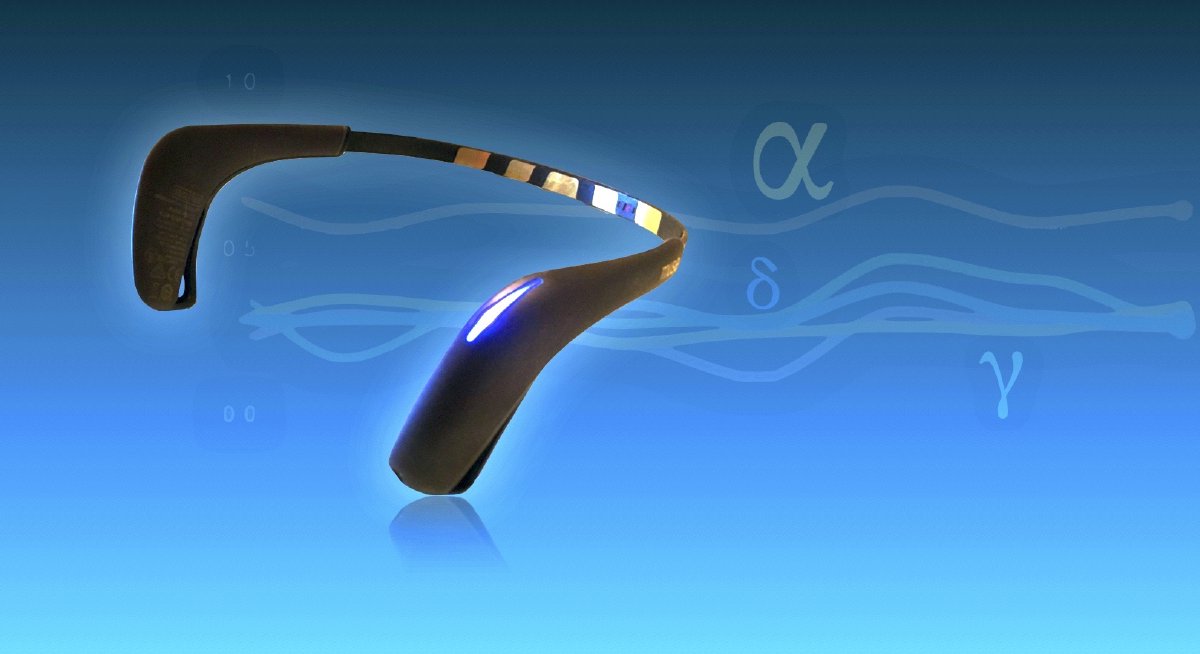Every couple of years, there’s an increase in devices that enable individuals to measure the bioelectrical activity of their brains at home. These devices exploit the occurrence of fluctuating brain wave frequencies, which vary according to the user’s psychophysical state. Driven by a pandemic-induced fondness for my residence, I decided to purchase one of these gadgets. After several weeks, I sought to offer a subjective review of the chosen model and conduct an experiment using raw data.
I had long contemplated purchasing an electroencephalography (EEG) device, but high prices and unconventional communication interfaces were deterring factors. This began to change a few years ago when several manufacturers started offering these devices for home use.
Home EEGs operate in a similar way to those used in the medical industry, though there are some notable differences:
-
They don’t utilize a high number of channels, typically averaging between 4 and 12.
-
Often, the use of electrodes requiring the application of a special conductive gel has been phased out.
-
There’s an understanding that less expensive and smaller sensors may produce noise and be sensitive to shifting environmental conditions. However, this is counterbalanced by specific algorithms that calibrate the data during processing by an app developed for a distinct purpose. If the primary aim is to boost concentration, precise, absolute signal values corresponding to brain waves aren’t so important. Approximate readings, relative to the levels measured at the start of the session, are sufficient.
Choice
Different brain activity measuring devices serve different purposes. Some enable users to control a computer by employing specific thought sequences, like manipulating characters in games. For others, the key feature is the support of biological feedback (biofeedback), which is useful in enhancing concentration or relaxation. There are also gadgets for DIY enthusiasts and researchers, as well as those intended for real-time brain activity imaging.
I chose the Muse 2 headband, designed for individuals wanting to improve their concentration and mindfulness skills. The initial months of the coronavirus pandemic impacted me significantly, prompting me to actively better my well-being through a balanced diet, physical exercise, and cognitive activities.
My decision was also swayed by the desire to validate various mind-working techniques that I’ve utilized over the years. To compare their efficacy and utility in achieving specific states, I needed to find common lexicons and maps across different systems. I also turned to pragmatic methods of examining the quality of basic mental functions such as alertness, mindfulness, focus, and awareness. Ideally, an fMRI device would be available to visualize the activity of all brain areas in real time.
Nonetheless, a straightforward EEG can provide significant support by addressing questions such as whether the state I subjectively deem as focused truly is, and whether my perception of a strong or weak focus is valid in comparison to my personal average.
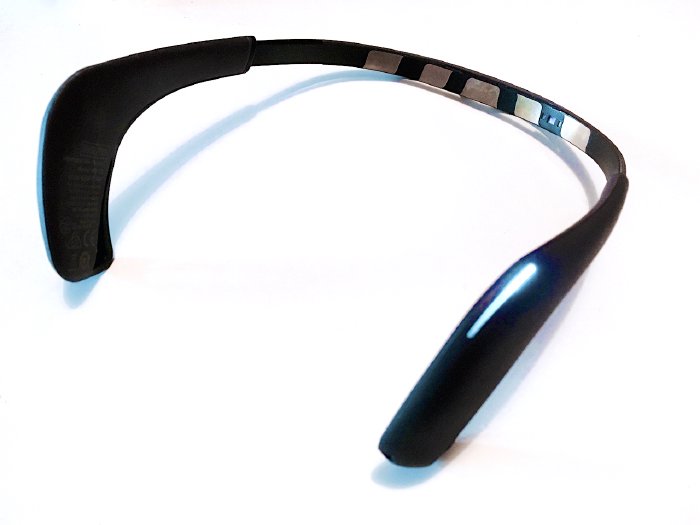
Muse 2 headband
Product
Muse 2 is a plastic headband designed to sit on the forehead, equipped with sensors, an amplifier, a signal sampler, a built-in battery, and a Bluetooth transceiver. It features:
- 5 EEG sensors for monitoring brain wave activity,
- A gyroscope for assessing the head’s position in 3D space,
- An accelerometer for gauging head movement acceleration,
- A photoplethysmograph for measuring heart rate and blood oxygenation.
This enables the utilization of various types of biological feedback:
- EEG biofeedback, using information about brain activity,
- HRV biofeedback, based on heart rate variability,
- Respiratory biofeedback, providing information about breathing,
- Postural biofeedback, monitoring the head position.
Additionally, the hardware interface of the headband is fitted with unique indicators that can be utilized by the software:
- A jaw-clenching detector,
- An eye-blinking detector,
- A forehead-touching detector,
- Horseshoe adhesion indicators.
A significant component of the package is the Muse: Meditation & Sleep application, designed for mobile devices (mobile phones and tablets) operating on Android or iOS. As suggested by its name, the application targets supporting meditation and relaxation practices. It offers various categories of exercises using different types of biofeedback, along with numerous guided meditations inspired by both traditional and contemporary practices.
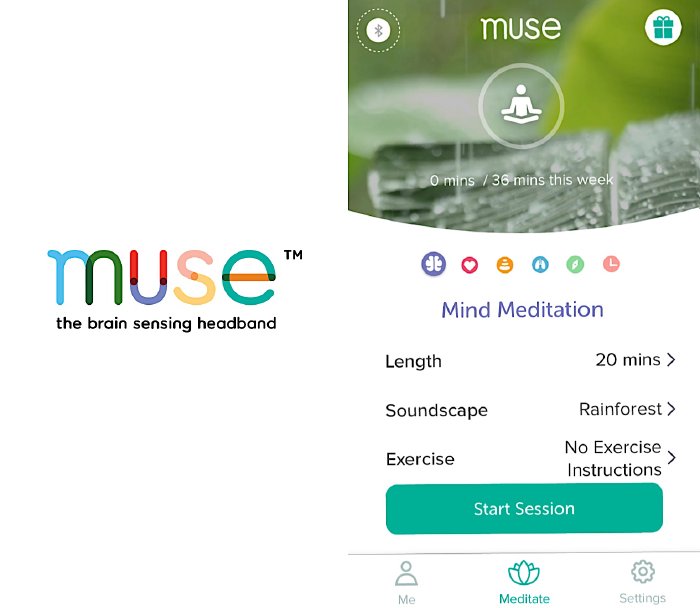
Muse: Meditation & Sleep app for iPhone
How does it work?
Operating the Muse 2 involves powering on the band by clicking the button on the right side, pairing it with a phone or tablet, and launching the application. Preparing headphones is also advisable if you wish to leverage the biofeedback.
So, what exactly is biological feedback? In 1885, physiologist Ivan Tarkhanov, known for creating a polygraph (commonly referred to as a lie detector), observed that a person could regulate their own heart rate using cerebral cortex impulses, not solely by decelerating their breathing. This indicates that we can control certain physiological processes that seem wholly automatic.
Biofeedback involves examining specific bodily functions (like heart rate, breathing, body posture, temperature, etc.) using suitable devices, or by consciously focusing on selected body areas to then manipulate them through voluntary effort. For instance, by listening to our heartbeat, we can speed up or slow down its rate and observe the effect of our actions. Such exercises can yield beneficial psychological effects as they fundamentally enhance the sense of coherence and foster mindfulness.
In the Muse application, you can select an exercise category, which determines the type of feedback used:
- Mind Meditation – supports mind calming by analyzing brain activity,
- Heart Meditation – teaches heart rate control,
- Body Meditation – promotes awareness of correct posture,
- Breath Meditation – aids in mindful breathing.
Furthermore, you can have a session without any feedback. In this case, there’s no need to wear the headband; the application merely times the remaining duration (Timer mode) and optionally provides some instructions.
Another category, Guided Meditation, utilizes biofeedback, and offers downloadable meditation instructions from various creators for free or at a fee (if you’ve purchased the cheaper version of the headband).
Upon setting the basic session parameters (duration, background sound, and choices regarding verbal instructions activation), you click the Start Session button, and the session begins. Depending on the chosen category, the initial several seconds to a minute involve a calibration process where the application learns your body and mind’s initial state.

Results screen in the Muse: Meditation & Sleep app
The application informs us about our current condition through background sounds. When these deteriorate (like when we become distracted or our heart rate increases), we hear a corresponding noise (raindrops, for example, in Mind Meditation). The more we deviate from the optimal values of the measured parameters, the louder the sound. But, if we do well and deepen our state, the background goes silent, and in Mind Meditation, we hear birds chirping.
The session concludes with a graph illustrating the quality of the practice over time. For Mind Meditation (with neurological feedback), there’s a calculated calmness level, referred to simply as Mind, which can belong to one of three ranges: active, neutral, or calm. In more recent versions of the application, there’s also a chart named Stillness, indicating the level of bodily tranquility, and another one titled Heart Rate, which is self-explanatory.
We also receive a certain number of so-called Muse Points rewarded for the session’s length and for deepening the desired state.
Using the application gives us access to the historical records of our sessions as well as their short summaries in the form of virtual badges, which we can share on social networks.
Attempts
Starting from October 12, 2020, I began experimenting with the Muse 2 headband, trying different modes and tweaking the session parameters. I decided to try the Mind Meditation practice according to the provided voice instructions, setting aside the methods I already knew.
I set up a dedicated testing station and, following the principles of Asian art, placed it next to a wall, which served as my temporary landscape for the coming weeks. To the left, I positioned a bell to signal the start and end of my introspective journey – a helpful aesthetic element.
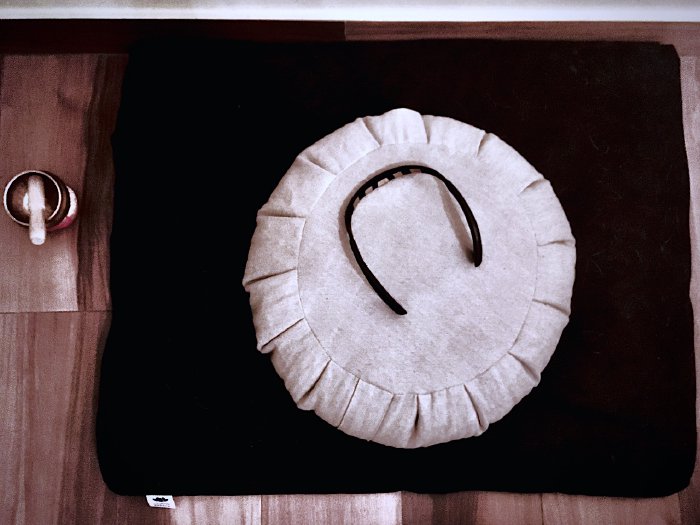
Paweł’s amazing adventures, i.e. neurofeedback diagnostic station
In the initial sessions, I had to grapple with the sense of being evaluated, which created some tension and prevented full relaxation. Online, I found others who had similar experiences, where the EEG feedback was triggering. The escalating sound of rain indicated a distraction or elevated heart rate, which, paradoxically, caused further emotional reactions that affected the quality of the session. This created a sort of negative feedback loop.
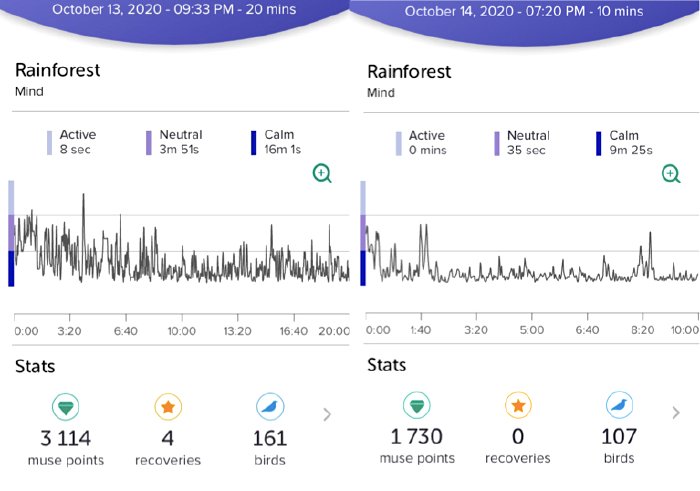
First sessions and some negative effect of neurological feedback
After a few sessions, I started to understand what the software was rewarding. I refer to it internally as “mudding”. According to the available materials, the calming level is a function of appropriately weighted values representing the absolute values of signals corresponding to individual brainwave bands. Essentially, what matters is, to put it simply, reducing their amplitudes. This can be achieved not just by focusing, but also by partially allowing oneself to drift into trance-like or near-sleep states.
Equipped with this understanding, I decided to keep trying and started to acclimate to the feedback system. I learned to perceive the sound of rain as a pleasant, temporary focus. As the bird chirps faded, I allowed myself to sink deeper into the soft, muzzy sensation of submerging into the physical sensations and breath. Focusing more on the exhalations than inhalations was helpful, as was deliberately lengthening breaths and gazing distantly until sight receded.
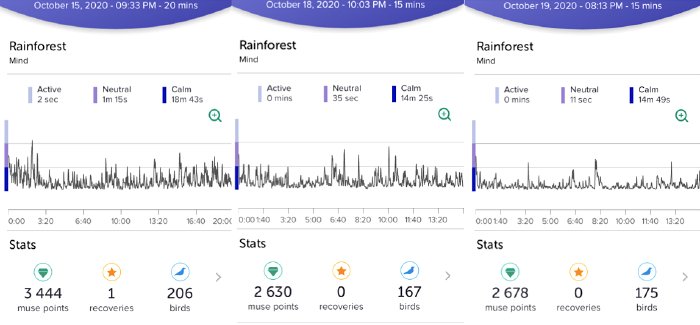
Subsequent sessions and much better effect of neurological feedback
The results improved, but I was curious to see if it was possible to achieve a 100% calm factor. So, after a few more tries, I decided to make two significant changes:
-
Mute the feedback sounds (via the app settings).
-
Abandon my initial assumption of relying solely on the application instructions, and instead draw from my experience with zazen, which also involves focusing on the breath.
In zazen, the principal aim isn’t mere relaxation or tranquility. Instead, it’s the capacity to remain engaged with the focal point, or maintain focus even in the absence of any object. Calmness of mind may arise as a by-product of concentration. Despite the instructions provided by the app sounding similar, the purpose of the practice differs, as does the level of determination during training. In zazen, when practicing breathing, you breathe with 100% attention, fully becoming the breath while walking the line between tension and peace. Yet, this does not exclude a kind approach to oneself, gently returning to concentration when drawn into thoughts – which is part of the point.
Surprisingly, after the first session following the new model, I felt it might be the least calm exercise yet. My state didn’t seem to have changed much, and there was more room for random thoughts that flowed in the background. However, this subjective assessment was inaccurate. Following the breath with open eyes and maintaining proper body posture led to a mental state that the device rated highly in terms of calmness.
I discovered that this state could be further deepened by using an accelerated, sharp method of dismissing emerging thoughts, redirecting attention, and intensifying focus on the breath. While this approach can be exhausting in the long run - forcefully cutting off thoughts before they fully form may drain energy over time - it can be used effectively for a few minutes at a time to increase the score in the application. This approach allows one to reach a state resembling sleep where thought lines, previously cut, can seep back and envelop the mind, albeit without a strong constructive and stimulating quality.
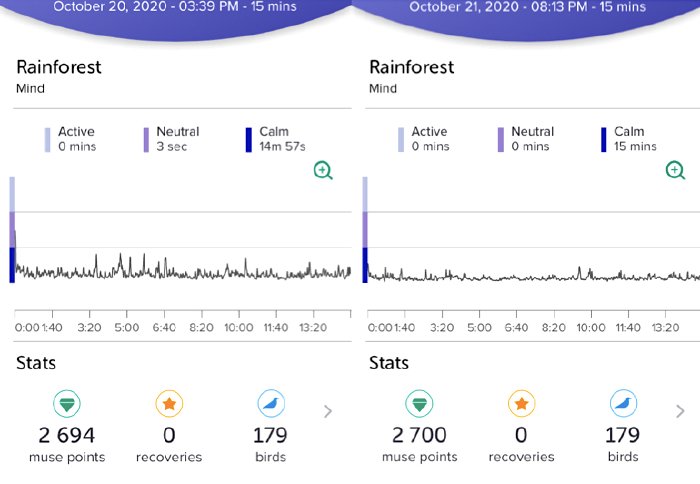
Recent test sessions and a satisfactory level of calmness
After the testing period, I started using the Muse device with fully muted feedback sounds, averaging over 95% calmness. For longer sessions, I opted not to wear the band but used the application to count down the time.
I would recommend the device to anyone interested in trying biofeedback to reduce stress or increase concentration under controlled conditions. However, I caution those who have been practicing within a meditative system for a longer period against unexpected results. Your method may induce states that aren’t highly scored by the device. Practices involving multi-object visualizations, emotional experiences, or physical sensations may inadvertently signal anxiety to the app. This is because certain brain areas may become active, producing brainwaves of frequencies that aren’t desirable in the context of evaluated calmness.
In hindsight, I don’t regret choosing this particular device. It’s valuable to occasionally apply objective measures to such subjective things as focus and peace of mind. It’s gratifying to observe one’s adaptive abilities, demonstrating them to oneself and one’s readers. And it’s comforting to recognize that achieving calmness and concentration is not an end in itself, but rather a means of facilitating insight and perspective shifts.
However, I missed a feature in the app that would allow access to raw data or visualization of individual brainwave frequency bands. This would have let me use the headband for various exercises, not just those proposed by the manufacturer. Furthermore, it would have allowed me to explore techniques to affect the bioelectrical activity of specific brain regions.
Experiment
Two weeks post the testing phase, I found myself contemplating alternative uses for the headband. One such thought was to experiment with various meditation techniques I was familiar with. However, an inherent issue was that the level of calmness was based on a pre-calibrated and computed value, derived from EEG sensor data. Could there be a way to directly access these readings?
Interestingly, the headband, which interacts with the app via Bluetooth, transmits data from each sensor independently. Back in 2016, a supplementary application was even launched for enthusiasts wanting access to this information. Additionally, a Software Development Kit (SDK) was published by the manufacturer. This allowed interested parties to integrate their own apps with the Muse bands. Unfortunately, this concept was later scrapped.
As of 2020, in my opinion, the most reliable method to acquire raw sensor data is through unofficial mobile applications like Wave or Mind Monitor. The former serves as a basic oscilloscope that can store EEG data in CSV format (Comma-separated values). The latter is a more sophisticated tool, featuring various chart types, a streaming server, and Dropbox integration.
Brainwaves
Before delving into the experiment details, let’s clarify the concept of brainwaves, or, more specifically, the cycles of bioelectrical brain activity, measurable via electroencephalographic sensors.
In 1924, the term electroencephalography (EEG) was introduced by German psychiatrist Hans Berger to denote the process of measuring brain electrical activity using scalp-attached electrodes. He observed that a person’s mood, arousal, focus level – in other words, their current state of consciousness – induces wave-like changes in electrical potentials. This insight fueled further research and provided a more objective way to “peek” into human minds, as compared to interviews or behavior observation.
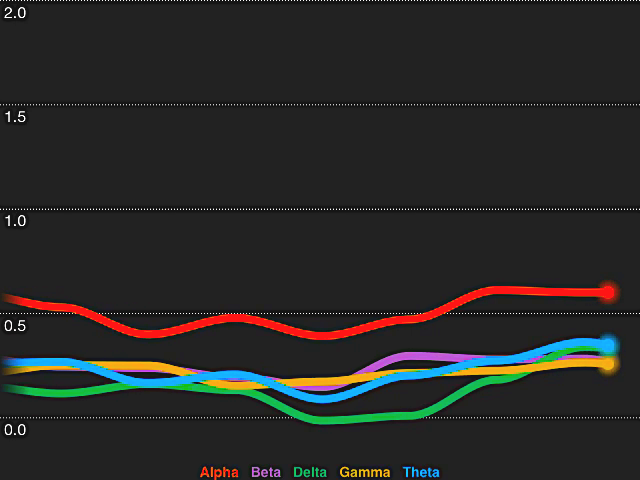
An example of EEG recording in the Wave application
Interestingly, when various neurons in different brain areas collaborate, they produce subtle electrical impulses with wave characteristics. These activities can be measured on the scalp surface using suitably sensitive instruments.
However, it’s important to know that we’re dealing with an input composed of multiple signals of varying frequencies. Thus, the equipment should appropriately filter these signals and segregate them into distinct bands. Consequently, we end up with several graphs displaying time-variable signals corresponding to the suitable frequency band. Each band in this spectrum is commonly named, and – in simplified terms – we can identify different kinds of these so-called brainwaves:
-
delta waves (δ) – fluctuating between 1/2 to 3 times per second, exhibit high amplitude and are predominant during the 4th phase of dreamless sleep (NREM);
-
theta waves (θ) – oscillate from 4 to 7 times per second and are present during deep meditation, hypnosis, and during intense emotional states;
-
alpha (α) waves – range from 8 to 13 times per second and are strengthened during relaxation and calm concentration;
-
beta (β) waves – fluctuating between 12 to 28 times per second, they represent everyday functioning (normal perception, mental effort);
-
gamma (γ) waves – range from 30 up to 100 times per second, signaling motion, intensive memory operation, as well as integrating sensory stimuli into conceptual content. In meditation, they indicate high awareness and/or engagement with higher feelings.
Among the above, alpha waves are the most recognized by the general public. Numerous books have been written about them, and in the twilight of the last millennium, they were touted as the key to rapid memorization. Alpha activity can be experienced every morning (right after awakening) and evening (prior to sleep), as well as during rest.
Discussing brain states in terms of brainwaves is a simplification. Looking at an EEG record, we observe signals from all these bands. Occasionally, some signals dominate – their amplitude is either unusually high, or their duration points to a specific state of consciousness (like in the case of gamma range).
Brainwave measurement is performed by summing up the weighted amplitudes of signals belonging to all available bands within a certain time frame, and calculating the average. This average then serves as the baseline against which the power of each separate band is reported.
Goal, means, methods
My experiment’s aim was to test several popular meditation techniques and discern which had the greatest potential to shift my state of consciousness.
From a neuroscience perspective, meditation is about inducing altered states of consciousness by modifying the nervous system’s default activity balance. Meditation’s common goal is transforming perceptions to gain insights into the true nature of mind and reality. This process may result in enduring changes in how one experiences oneself and the world.
My focus would primarily be on three types of waves: alpha, theta, and gamma. Signals within these frequency bands interest me as they indicate calmness of mind (alpha), deep meditation (theta), and deep insight or higher feelings (gamma).
If necessary, I’d discount the beta (wakefulness) and delta waves (deep sleep) to negatively score states of intellectual agitation or exhaustion.
For my research, I opted to undertake the following practices:
- breath counting with open eyes,
- following the breath with open eyes,
- meditation without an object,
- tantric practice with yidam and mantra,
- benevolence cultivation.
The first practice, breath counting, is a concentration exercise where one counts exhalations or complete breaths from 1 to 10. This method can induce relative mental calmness and is often a precursor to following the breath.
Following the breath is a technique that leads to achieving what is termed as access concentration (Pāli: upacāra samādhi). This type of concentration results in calming the mind (Pāli: samatha, Sanskrit: śamatha, Tibetan: shyiné), paving the way for other practices and associated consciousness states: meditative absorption (Pāli: jhāna, Sanskrit: dhyāna), mindfulness (Pāli: sati), the foundation of insight (Pāli: vipassanā), and the methods for triggering pure awareness without a specific object.
Meditation without an object (also termed as objectless meditation or seedless meditation) involves maintaining concentration without focusing on a single object or hopping between several attention objects. It heightens awareness and leads swiftly to insight but can be challenging for beginners due to the ease of being ensnared by thought streams. One variant includes the practice of just-sitting (Japanese: shikantaza) from the Soto school of Zen.
The Tibetan practice of yoga tantra (a class of tantra in the Sarma variant of Mahamudra) involves calming the mind, adopting the appropriate attitude, arousing the mind of awakening (Sanskrit: bodhicitta), and visualizing a meditative deity (Tibetan: yidam, Sanskrit: iṣṭadevatā) in close proximity. These stages are followed by the mantra phase, involving the repetition of syllables linked to the meditative aspect. Focus can shift between objects, such as the mantra sound, yidam qualities, and letters symbolizing the mantra (repeated aloud or mentally). The practice concludes by merging the yidam within oneself and/or dissolving all the phenomenal world.
The final method tested is metta meditation, also known as loving-kindness meditation or benevolence cultivation (Pāli: mettā bhāvanā). After calming the mind for a while, one works with an intention (potentially supported by visualization), formulating wishes for the benefit and happiness of all beings, which leads to awakening oneself in loving-kindness (Sanskrit: Maitrī, Pāli: Mettā). This can induce pleasant emotional or bodily states, akin to those experienced during initial absorption in concentration practices.
Execution
Each practice was allotted about 5 minutes. While this might seem brief, it is sufficient to observe different characteristics of the EEG. Each session began with assuming a posture and relaxing for approximately a minute, and it concluded with relaxation and physical movement after the stipulated time. The intent was to prevent the transfer of consciousness states between successive methods.
For each exercise, I had a plan that my companion read aloud, which allowed me to know when to commence and conclude specific meditation phases and refer to them in my analyses.
Throughout the meditations, I wore the Muse 2 band connected to the Wave application, which recorded the five frequency bands of my brainwaves. Below is a visual representation of their real-time changes, with background music added later:
You can enable subtitles in the player by pressing the CC button – both English and
Polish are available. They provide additional information about the stages of each
method. There are also links that open the clip at points where the subsequent
practices are recorded. These can be found in the description of this material on the
video hosting platform or below:
- breath counting,
- following the breath,
- tantric practice with yidam and mantra,
- objectless meditation,
- the cultivation of benevolence.
Data
With the EEG records in CSV file format, I was ready to begin my calculations. I aimed to identify which practices strengthened alpha, theta, and gamma waves the most.
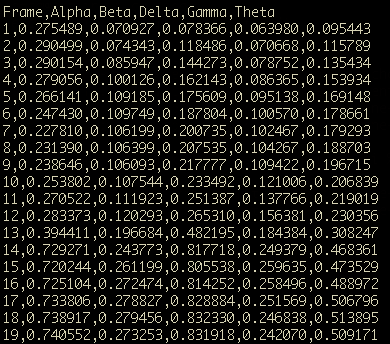
EEG recording from Wave application in CSV format
Examining the CSV file data, we can observe the absolute signal values for each frequency band. The title of the first column suggests there’s also information about the so-called frame. Essentially, this is the number of the next sample gathered over time, with a sampling rate of 10 times per second.
I consolidated the data from each individual session (saved in separate files) using the popular Excel spreadsheet. In total, the quantity was not so great that it necessitated writing a computer program, and the calculations were not so complex that a spreadsheet couldn’t handle them.
Following the data consolidation, it was time to pinpoint the most interesting moments, meaning the elimination of the “warm-ups” and the conclusions of each practice. By replacing the frame numbers with a time interval (expressed in minutes and seconds), we were ready to proceed.
From each session’s five-minute sampling periods, I extracted a 3-minute and 15-second timeframe, which encompassed the most crucial parts. The initial cut was performed at 1.30 (after relaxation and initial mental calm), and the final cut was made at 4.45 (before the end of the session).
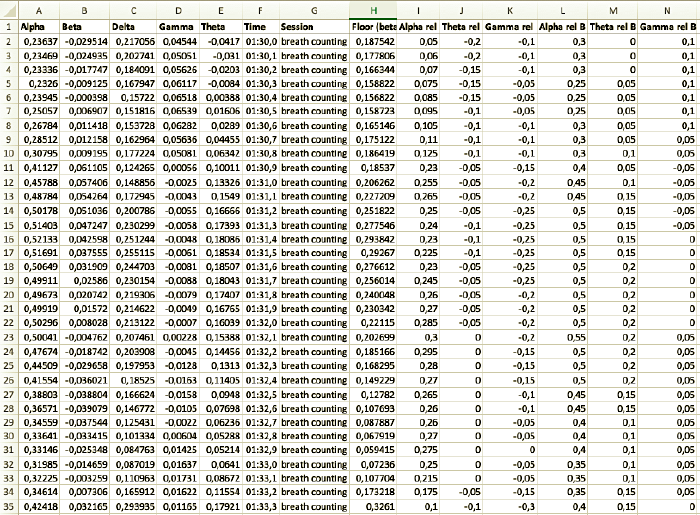
Consolidated EEG recording from Wave application in a spreadsheet
In the screenshot above you can see some extra columns with data:
FTime is the relative time calculated from the sample number,GSession stores the name of the meditation session,HFloor (beta+delta) is the sum of signals for the beta and delta bands,IAlpha rel is the difference between alpha power and the floor fromH,JTheta rel is the difference between theta power and the floor fromH,KGamma rel is the difference between gamma power and the floor fromH,LAlpha rel B is the difference between alpha power and beta fromB,MTheta rel B is the difference between theta power and beta fromB,NGamma rel B is the difference between gamma power and beta fromB.
The columns with “rel” in their names are utilized to adjust the absolute signal values representing alpha, theta, and gamma waves. The first three columns will rectify these values by deducting the sum of the beta and delta power, and the latter three will only deduct the beta power. This allows us to obtain the greatest difference between the power of a particular signal and the power of signals that are undesired in the context of meditation practice.
In the first group of corrections (I, J, K), I take delta waves into account
because such brief practice does not denote a deep altered state, but rather everyday
fatigue and drowsiness. In the second group (L, M, N), only the beta value is
subtracted. This difference should ideally provide me with more precise data about
the altered state during meditation as I am only subtracting the power values of the
beta signal, leaving the delta band signals which are known to naturally have high
amplitudes.
Calculations
Let’s perform calculations for each practice. Using the data series that depict signal strengths of alpha, theta, and gamma brainwaves, I will determine averages and medians, and then execute comparisons (direct or by applying certain relativizing coefficients).
The average and median values of signal strengths for the crucial types of brainwaves were adapted using the three methods (stated earlier) before their implementation in calculations:
- absolute (unchanged values),
- relative to the sum of the beta and delta signal values,
- relative to the value of the beta signal.
In presenting the results, I exclude the calculated average values as they do not significantly deviate from the medians, leading to similar conclusions.
Absolute Medians
The signal strengths’ absolute values will be utilized to compare the strengths of individual waves, thereby identifying the dominant bands in specific techniques. This analysis, however, does not provide insights into the “purity” of a practice or its effectiveness in attaining the desired state, as it does not consider the influence of undesirable waves.
| alpha | theta | gamma | practice |
|---|---|---|---|
| 0,59 | 0,20 | 0,00 | breath counting |
| 0,71 | 0,33 | -0,10 | following the breath |
| 0,66 | 0,31 | 0,22 | yoga-tantra with mantra |
| 0,53 | 0,19 | -0,06 | objectless meditation |
| 0,55 | 0,19 | 0,18 | loving-kindness |
Winning methods:
- concentration, deep meditation: following the breath;
- synthesis / higher feelings: yoga-tantra with mantra.
Means of Absolute Medians
By averaging the medians from the “Absolute Medians” table, we can determine the relative levels of calmness and mental activity (arousal) in a manner similar to that employed by neurofeedback apps.
| α, θ, γ | practice |
|---|---|
| 0,27 | breath counting |
| 0,31 | following the breath |
| 0,40 | yoga-tantra with mantra |
| 0,22 | objectless meditation |
| 0,31 | loving-kindness |
Winning methods:
- the highest arousal: yoga-tantra with mantra;
- the highest calmness: objectless meditation.
Medians Relative to β+δ
We will utilize the signal strength values for the bands of interest, which have been adjusted by subtracting the strengths of the beta and delta signals. This analysis will help us identify the bands that stand out from the others and those that exhibit relatively similar amplitudes.
| alpha | theta | gamma | practice |
|---|---|---|---|
| 0,20 | -0,15 | -0,35 | breath counting |
| 0,09 | -0,25 | -0,70 | following the breath |
| -0,12 | -0,40 | -0,50 | yoga-tantra with mantra |
| 0,32 | 0,00 | -0,25 | objectless meditation |
| 0,19 | -0,15 | -0,15 | loving-kindness |
Winning methods:
- concentration, deep meditation: objectless meditation;
- synthesis / higher feelings: loving-kindness.
Means of Medians Relative to β+δ
By utilizing the data from the table “Medians Relative to β+δ” we can compute the averages that will enable us to identify which practice exhibits waves with the highest signal power on average.
| α, θ, γ | practice |
|---|---|
| -0,10 | breath counting |
| -0,29 | following the breath |
| -0,34 | yoga-tantra with mantra |
| 0,02 | objectless meditation |
| -0,04 | loving-kindness |
Winning methods:
- the greatest distinction of the bands of interest: objectless meditation;
- the greatest diversity of all bands: yoga-tantra with mantra.
Medians Relative to β
Utilizing values adjusted by the strength of beta wave signals will allow us to identify techniques that induce the most significant alterations in the state of consciousness. These techniques are the ones that differ the most from the brainwave patterns observed during ordinary activity.
However, it is important to note that comparing the dominant waves in specific methods using this frame of reference would introduce an error. This error arises from disregarding the states of sleepiness characterized by delta waves.
| alpha | theta | gamma | practice |
|---|---|---|---|
| 0,55 | 0,15 | -0,05 | breath counting |
| 0,65 | 0,25 | -0,15 | following the breath |
| 0,40 | 0,05 | -0,05 | yoga-tantra with mantra |
| 0,55 | 0,20 | -0,05 | objectless meditation |
| 0,40 | 0,00 | 0,00 | loving-kindness |
Winning methods:
- concentration, deep meditation: following the breath;
- synthesis / higher feelings: loving-kindness.
Means of Medians Relative to β
Here is the improved version of the previous table, which reflects the methods that cause brainwaves to be the most distinct from regular beta waveforms.
| α, θ, γ | practice |
|---|---|
| 0,22 | breath counting |
| 0,25 | following the breath |
| 0,40 | yoga-tantra with mantra |
| 0,23 | objectless meditation |
| 0,13 | loving-kindness |
Winning methods:
- the most altered state: yoga-tantra with mantra;
- the most ordinary state: loving-kindness.
Waves Plebiscite
The calculations presented below aim to showcase the brainwaves that are specific to each practice. Due to the varying amplitudes of brainwaves in different frequency bands, we need to determine appropriate weights to convert values from different brainwave types into a common range.
Comparisons based on absolute values from different wavelengths or values adjusted by the initial calibration reading (not utilized here) would be flawed since signal amplitudes possess inherent characteristics linked to the specificity of respective brain regions. For instance, certain types of brainwaves tend to have lower minimum and maximum values, similar to the calculated average, even though exceeding a certain threshold could indicate an unusual phenomenon. Therefore, let us attempt to establish scales based on the mean values derived from the previously presented “Absolute Medians” table for individual practices. By using medians as the base instead of all values, we can accentuate the differences to some extent.
| alpha | theta | gamma | α, θ, γ |
|---|---|---|---|
| 0,62 | 0,24 | 0,09 | 0,32 |
Based on the means of the individual brainwave bands from the previous table of
medians and the average of these means, we can calculate the comparison coefficients
(Cs) as follows:
| Cα | Cθ | Cγ |
|---|---|---|
| 0,52 | 1,3 | 3,6 |
Now, let’s utilize the previously obtained medians and calculate the values by applying the coefficients to compare the different brainwave types across each practice. Our goal is to identify distinctive values in each row:
| alpha | theta | gamma | practice |
|---|---|---|---|
| 0,31 | 0,27 | 0,00 | breath counting |
| 0,37 | 0,43 | -0,36 | following the breath |
| 0,34 | 0,40 | 0,79 | yoga-tantra with mantra |
| 0,28 | 0,25 | -0,20 | objectless meditation |
| 0,29 | 0,25 | 0,64 | loving-kindness |
As a result:
- In the practice of breath counting, the distinctive brainwaves are alpha.
- In the practice of following the breath, the distinctive brainwaves are theta.
- In the practice of yoga-tantra, the distinctive brainwaves are gamma.
- In the practice of objectless meditation, the distinctive brainwaves are alpha.
- In the practice of loving-kindness, the distinctive brainwaves are gamma.
By the term “distinct”, I refer to the predominance of the weighted median of the brainwave signal associated with a specific band. This signal is transformed using a coefficient calculated by taking a comprehensive series of experimental data. This method allows us to identify the most significant deviations among brainwave types in relation to the compared practices. For instance, when counting breaths, the disparities in signal values between alpha brainwaves and other brainwave bands are the most prominent. However, this does not imply that other brainwave signals measured absolutely will not prevail in this particular practice. In the case of counting breaths, alpha waves exhibit the most significant positive change when compared to other practices.
Naturally, these observations pertain to my own brain, mind, and personal practices. It is worth noting that different individuals and varying conditions may yield different outcomes. Nevertheless, these results largely align with the commonly available knowledge regarding the impact of meditation on the brain’s bioelectrical activity.
Weighted Medians Relative to β+δ
With the availability of the comparison coefficients, it would be beneficial to compute an additional table that signifies the “purity” of a given practice by exclusively examining the signals that are desired for that specific method. This table will serve as an enhanced rendition of the “Means of Medians Relative to β+δ” table. Initially, I will generate an auxiliary table derived from the “Medians Relative to β+δ” table, but this time, I will transform the values using the aforementioned coefficients.
| alpha | theta | gamma | practice |
|---|---|---|---|
| 0,1 | -0,19 | -1,26 | breath counting |
| 0,05 | -0,33 | -2,52 | following the breath |
| -0,06 | -0,52 | -1,8 | yoga-tantra with mantra |
| 0,16 | 0,00 | -0,9 | objectless meditation |
| 0,09 | -0,33 | -0,54 | loving-kindness |
Weighted Means of Medians Relative to β+δ
This variant represents an enhanced version of the previous table, as it incorporates the means of alpha, theta, and delta signals that have been adjusted with coefficients. By considering these adjusted values, it will identify the practice that is the most “pure” among all others.
| α, θ, γ | practice |
|---|---|
| -1,35 | breath counting |
| -0,93 | following the breath |
| -0,79 | yoga-tantra with mantra |
| 0,25 | objectless meditation |
| -0,26 | loving-kindness |
Winning method:
- the most “pure”: objectless meditation.
Optimal practice
When referring to an “optimal practice”, I mean a practice that satisfies the following criteria:
-
It resonates with me on a personal level, meaning it comes naturally to me and feels comfortable.
-
It produces the expected outcomes in terms of altering my state of consciousness.
Thanks to the previous calculations, I can now focus on relatively objective indicators for these aspects. Therefore, I understand the term “comes to me best” as follows:
-
The method is considered “pure”, indicating a significant difference in signal amplitudes between desired and undesired brainwave bands.
-
The method facilitates a reasonably high level of calmness, with all brainwave signals below a certain threshold when considering their absolute values.
-
The method facilitates deep meditation in the context of altered states of consciousness.
To assess the level of “purity”, I can refer to the “Weighted Medians Relative to β+δ” and “Weighted Means of Medians Relative to β+δ” tables. The ability to calm the mind can be evaluated using the “Absolute Medians” table. Information from the “Means of Medians Relative to β” table, combined with insights from the Waves Plebiscite section, can shed light on the potential for achieving deep meditation.
These criteria are the result of my chosen path of development, with a focus on deepening the level of calmness in order to explore techniques related to meditative absorption. I consider the “purity” of a practice as an indicator of my mind’s inclination to engage in it.
In terms of achieving expected results, the Waves Plebiscite calculation will be valuable. Since specific frequency bands of brainwaves are associated with particular states of consciousness, it is sufficient to determine which practices have the potential to induce them.
I will also include information about secondary characteristic brainwave types in each practice to diversify the list with additional variations of states.
| practice | bands | state of consciousness |
|---|---|---|
| following the breath | θ δ | deep meditation with concentration |
| breath counting | δ θ | concentration with moments of a deep meditation |
| objectless meditation | δ θ | concentration with moments of a deep meditation |
| yoga-tantra with mantra | γ θ | synthesis and higher feelings in a deep meditation |
| loving-kindness | γ δ | synthesis and higher feelings in a concentration |
An example that highlights the importance of formulating conclusions carefully based solely on a comparison of the most prominent brainwave signals for each practice is objectless meditation. At first glance, it appears to possess similar qualities to counting breaths, which is considered the most preliminary method. Objectless meditation is characterized by dominant alpha brainwaves associated with concentration, relaxation, and moments of deep meditation. However, this information alone does not provide insights into the suppression of other brainwave signals during the practice or the distance between their average signals and the average of alpha signals.
To obtain a more comprehensive understanding, we need to refer to the “Medians Relative to β+δ” and “Means of Absolute Medians” tables. These tables reveal that objectless meditation exhibits the largest disparity between desired and undesired brainwave bands. This suggests a heightened level of concentration and potential for deep meditation, with alpha and theta waves prevailing. Additionally, this method demonstrates the highest absolute level of calming the mind. Therefore, it significantly differs from counting breaths, although there may be initial similarities in terms of states of consciousness, at least during the first five minutes.
This example emphasizes the necessity of considering additional factors and referring to specific tables to gain a more nuanced understanding of the characteristics of each practice.
Summary
Allow me to condense the gathered information into a table of characteristics:
| quality / method | FB | BC | OM | YT | LK |
|---|---|---|---|---|---|
| “purity” | ✅ | ✓ | |||
| calming the mind | ✓ | ✅ | |||
| arousal | ✅ | ✓ | |||
| altered state | ✓ | ✅ | |||
| ordinary state | ✓ | ✅ | |||
| synthesis / higher feelings | ✅ | ✅ | |||
| concentration | ✓ | ✅ | ✅ | ✓ | |
| deep meditation | ✅ | ✓ | ✓ | ✓ | |
| diversity | ✓ | ✅ |
Legend:
FB– following the breathBC– breath countingOM– objectless meditationYT– yoga-tantra with mantraLK– loving-kindness- ✅ – primary quality
- ✓ – secondary quality
Now, let’s determine which practice exhibits the most favorable qualities and is therefore better aligned with my mind. I will assign double points to distinguishing qualities and single points to secondary qualities. Additionally, I will consider the initial assumptions, namely that the practice must induce calmness, possess a high level of “purity,” and bring about a change in the state of consciousness.
To facilitate a more comprehensive comparison of the various features, it would be beneficial to establish a set of precise measurable parameters that represent them. I will consolidate opposing characteristics, such as activity and calmness, as well as the distinction between altered states and ordinary states.
| quality / method | FB | BC | OM | YT | LK |
|---|---|---|---|---|---|
| “purity” | -0,93 | 1,35 | 0,25 | -0,79 | -0,26 |
| arousal | 0,31 | 0,27 | 0,22 | 0,40 | 0,31 |
| altered state | 0,25 | 0,22 | 0,23 | 0,40 | 0,13 |
For the data in the “arousal” row, which represents the opposite of calmness in terms of the absolute activity of signals from all bands, I will transform them to reflect “calmness” by mirroring the values around their mean:
| quality / method | FB | BC | OM | YT | LK |
|---|---|---|---|---|---|
| “purity” | -0,93 | -1,35 | 0,25 | -0,79 | -0,26 |
| calmness | 0,29 | 0,33 | 0,38 | 0,20 | 0,29 |
| altered state | 0,25 | 0,22 | 0,23 | 0,40 | 0,13 |
Next, I will standardize the scales of each quality by transforming their values into comparable dimensions. I will utilize 1st degree polynomials with the previously calculated parameters (assuming scaling each value to the range from 0 to 1):
purity: a=0,63 b=0,84;calmness: a=5,5 b=-1,1;altered state: a=3,7 b=-0,48.
The resulting sheet appears as follows (with rounded boundary values to zeros or ones):
| quality / method | FB | BC | OM | YT | LK |
|---|---|---|---|---|---|
| “purity” | 0,25 | 0,00 | 1,00 | 0,34 | 0,67 |
| calmness | 0,50 | 0,72 | 1,00 | 0,00 | 0,50 |
| altered state | 0,45 | 0,33 | 0,37 | 1,00 | 0,00 |
| AVERAGE: | 0,40 | 0,35 | 0,79 | 0,45 | 0,39 |
Among the techniques listed above, the following practices exhibit the characteristics that best align with the original assumptions and measurable indicators related to the desired qualities:
- objectless meditation (0,79)
- yoga-tantra with mantra (0,45)
- following the breath (0,40).
The optimal method for the presumptions made, in this case, is objectless meditation. This selection, however, poses a certain technical problem because during the practice of absorptions, which I’ve recently been exploring, a pleasing mental formation becomes the focal point after a certain period. This encourages the focus to self-sustain, deepening the state. I believe on this particular journey, I will engage in following the breath, transitioning to objectless practice when absorption does not happen after a while or once it has taken place.
Interestingly, the second position is held by the tantric practice. This method was characterized by the most transformed state of consciousness and the least degree of absolute tranquility compared to other techniques. This condition was due to the presence of gamma and theta brainwaves, the enhancement of which occurred without the gradual deepening of focus. This result was thanks to the psychological trigger related to a specific meditation deity, leading to an instant change of state within a handful of seconds.
I trust this experiment will inspire someone to engage in practice and/or conduct similar research at the intersection of neuroscience and practical spirituality.
Conclusions
Biological feedback, especially neurofeedback, can greatly enhance meditation and relaxation practices. The neuroplasticity of our brains allows us to build our concentration and tranquility capabilities by observing the day-to-day effects. EEG biofeedback also proves helpful during periods of uncertainty. It can assist when we struggle with a subjective evaluation of our concentration level and need to “tune” our practice to our current state. In this sense, it becomes a somewhat automated, albeit soulless, version of a meditation teacher. :)
With the Muse 2, designed for mind exercises, I can offer these observations:
-
If the feedback on successes and failures induces tension and works against the goal, it is advisable to lower the volume of the feedback sounds (via app settings). I recommend several sessions of simply listening to the sound of rain to associate it with a calming sensation, disregarding point count.
-
When doing custom meditation practices, you can still measure calmness. However, certain meditation techniques may yield entirely unpredictable results. This is a natural effect as not all mind practices rely on total relaxation where all types of brainwaves diminish in power.
-
Periodically trying other available exercises (e.g. related to heartbeat, breathing, or maintaining proper posture) is beneficial, even if your goal is concentration or calmness. This readies the body to work with the mind, positively impacting practice quality.
-
Regularly and systematically carrying out practice, ideally at the same time daily (preferably pre-meal), is a good habit. Much like physical training, mental conditioning can’t be done in advance. Ten minutes daily can yield better results than a few hours sporadically.
-
You may rapidly achieve a 100% calm level through various tricks influencing brain bioelectric activity. However, over time, this approach can foster harmful habits, leading to heightened tension, withdrawal, or energy loss in daily situations. It’s worth allowing yourself time and space to experience relaxation, even if it costs some Muse points. This associates practice with something pleasant and non-judgmental rather than another obligation.
-
If you have extensive experience in mind work and long-term meditation practice, you might inaccurately perceive your calmness as low. EEG readings can help you realize that calming your mind is concentration-dependent, particularly in early meditation stages. Hence, maintaining some mental discipline at the outset of practice isn’t undesirable, even if it appears as excessive tension, especially following popular online relaxation-focused instructions. While relaxation is vital, concentration is the key to most methods’ success. Balance is key.
Update [2023]
After a few months of using the band, I stopped using it regularly, only to return to systematic use of a newer edition known as Muse S in 2023. It differs from the previous edition in that it also allows us to examine the course of our sleep, thanks in part to its flexible construction. The device uses sensors placed in stretchable material with an adjustable diameter.
Exercises
For over 3 months, the band was tested by me at least twice a day in neurological biofeedback mode. I used two types of exercises:
-
focusing on an object in the form of bodily sensations (breath) or auditory stimuli (ambient sounds),
-
maintaining open awareness, encompassing both external and internal sensations.
Observations
In open awareness practices (also called effortless presence practices), where the object of concentration (if it can be so termed) is not a selected element of the internal or external area, but rather a notion of the ability to notice everything, it is easier to achieve high levels of calm as there is no disruption caused by fatigue or weariness.
Conversely, in concentration practices, the level of calm can fluctuate, although we are able to more quickly change the overall state of consciousness and achieve a relatively high level of calmness from the very beginning (after a few seconds). The initial risk is also a greater chance that the habitual mind will get bored with the focus object and start generating frustration or projecting visions of the future or memories of the past.
Absorptions
In some developmental paths (e.g., Buddhist Theravada), we deal with cultivating the so-called absorption (Pali: jhāna). It is achieved by arousing the aforementioned access concentration, and then relaxing while resting at the focus object, until feelings of joyful upliftment (Pali: pīti) and calm happiness (Pali: sukha) begin to appear.
In the mind of the practitioner, a kind of feedback loop then arises, i.e., the object of concentration ceases to be the chosen object, but becomes the pleasant experience (initially physical) born of concentration. Further focusing on this pleasant feeling causes an even greater feeling of happiness, and we are dealing with a self-sustaining meditative absorption.
When using the Muse band in such practice, we may notice that during the experiencing of factors associated with this kind of samādhi, calming indications will be disturbed by elements of arousal and mental activity. As a result, on the summarizing chart, we will notice a lot of star pictograms (returning to calmness) alternating with bird icons (deep calmness achieved). My hypothesis is that during the pleasure experienced as a result of absorption, enhanced theta and gamma waves begin to appear, which in a medical situation could be interpreted as a mild epileptic seizure.
It is worth remembering that in the case of performing practices in which absorptions or similar states occur, the calmness measured by the application may be disrupted by them.
Changing Gears
Another example, which suggests treating averaged and calibrated EEG records in a less arbitrary way, will be mind work practices in which we must make threshold transitions between states of consciousness, which may involve temporary release or dispersion of attention. At such moments, changes in the strength or amplitude of theta, gamma, and even delta waves may appear, which will ultimately be negatively assessed in the context of the application’s level of calmness.
For example, to deepen the level of access concentration required in many practices, at a certain key moment (at least in my case), scatter attention and allow oneself a momentary immersion in the experience of soaking in the generated field of calmness. As a result, various momentary experiences may appear, and when the practice is performed in the evening, even so-called hypnagogic jerks may occur, during which the brain sends contraction signals to the muscles to make sure the body has already been immobilized for sleep. If we are in the correct position (sitting with a straight spine), we are able to use the energy generated from these to clarify the mind and pass the threshold element of the practice.
I sometimes compare this to changing gears while driving a car. Pressing the clutch will be an analogy to momentary dispersion or change of focus object to start the next cycle at different rotations.
Concentration exercise with the band may therefore sometimes resemble driving in one gear, as pressing our mental clutch to change rotations is low-scored and generates negative neurological feedback. The mind reflexively tries to compensate for this undesirable state and too quickly returns to intensive focus.
It is still a useful lesson, you can even learn to maneuver our mental vehicle in this way, but in the context of practice, it may be an obstacle in smoothly transcending its stages. The solution will be to use the band for exercises that do not require this type of deepening of the state, or to resign from neurological feedback by muting the sounds.
Early Warning
In September 2023, I experienced a multi-day cold. Interestingly, already 2 days before the first symptoms appeared from the respiratory and sinus system, the calmness level shown by the app significantly decreased (by about 20–30%). Subjectively, I felt calm, but objectively the level of focus and associated mental calmness was lower than the average of several months.
Combined with other ways of monitoring body condition, it can be an interesting way of early warning in case of recurring ailments, and also during plans that may be thwarted by illness states.
Background Sounds
One morning, I decided to practice open awareness on the terrace in the garden. The sun had already risen, and its rays were becoming warmer, although they still did not cause discomfort. At that time, about a hundred meters away, someone also decided to take advantage of this beautiful moment and started a gasoline lawnmower:
I expected that the headband indications after the session in such an environment would be disturbed by a strong auditory stimulus, but I was very wrong. It turned out that the relatively uniform noise accompanying the works (which lasted for another 2 hours after the session ended) was an ideal background that balances the drowsiness accompanying relaxation.
At the very beginning, I applied a certain mental hack, allowing the intense background sounds to penetrate and trigger emotional responses in the body (in my case it was a kind of frustration experienced in the area of the solar plexus), which I then observed until they faded; remembering, however, about other sensations.
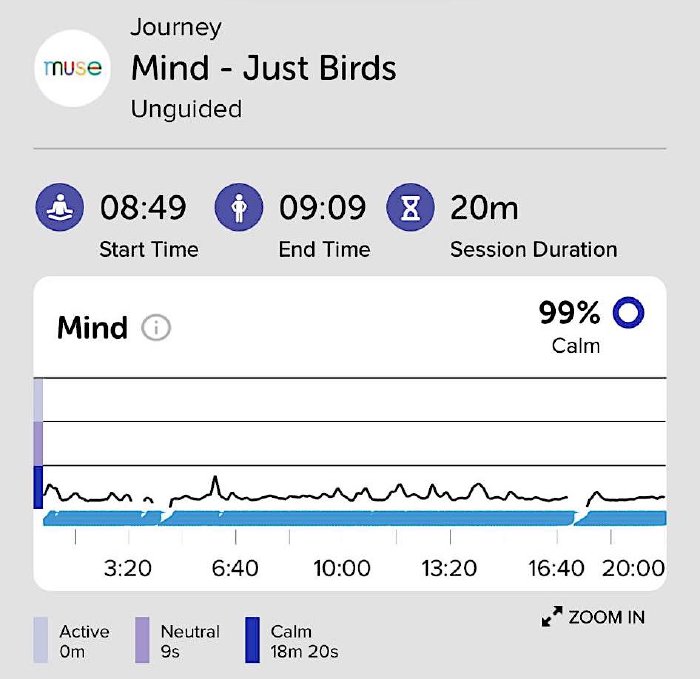
Record from the session of open awareness practice supported by the sound of a gasoline lawnmower
With a clear conscience, I can therefore recommend gasoline lawnmowers as a good object supporting the practice of open awareness!
Delegating Competence
The most painful observation I made after a longer and more intense use of the Muse headband to support other mind-training practices is the mechanism of delegating competence appearing already after a few weeks of use. More precisely, it’s about a certain kind of outsourcing of the ability to detect distraction and return to the object of focus.
The human brain is able to give up triggering certain paths of action if it notices that it is not necessary for the proper functioning of the organism in the world. In this way, it saves energy, of which it is the largest consumer. So when we put on the headband and turn on neurofeedback, we release it from the necessity of monitoring the current situation for distraction. From this moment, this function is taken over by an external device, and our thinking organ can relax.
After some time, a habit is formed. When we try to focus on an object without the headband and the app, we notice that it is slightly hindered: for example, thought sequences, intention streams, internal images, or sounds may appear, which will be recognized, but after a longer time than before getting used to the help of the headband.
The remedy for the above seems to be the previously mentioned distinction between exercises with the headband, and formal practice with the mind, or an alternative in the form of resigning from neurological feedback.

